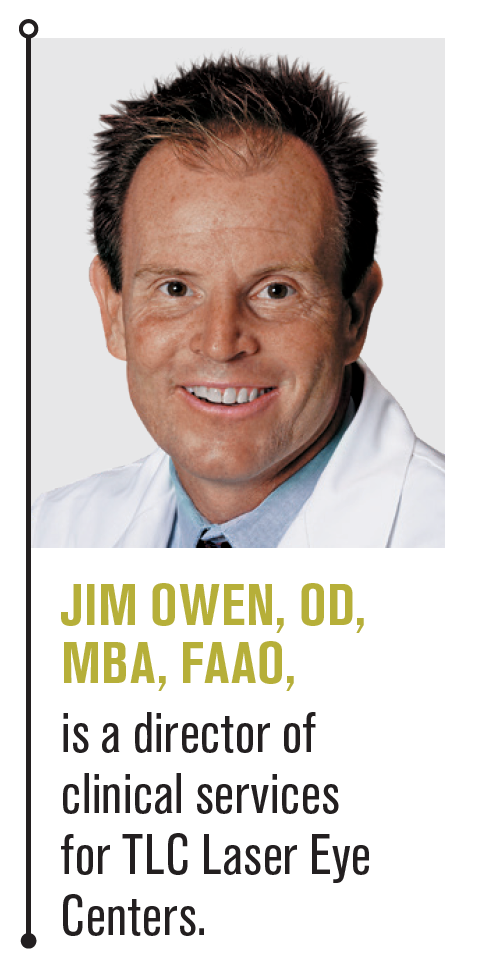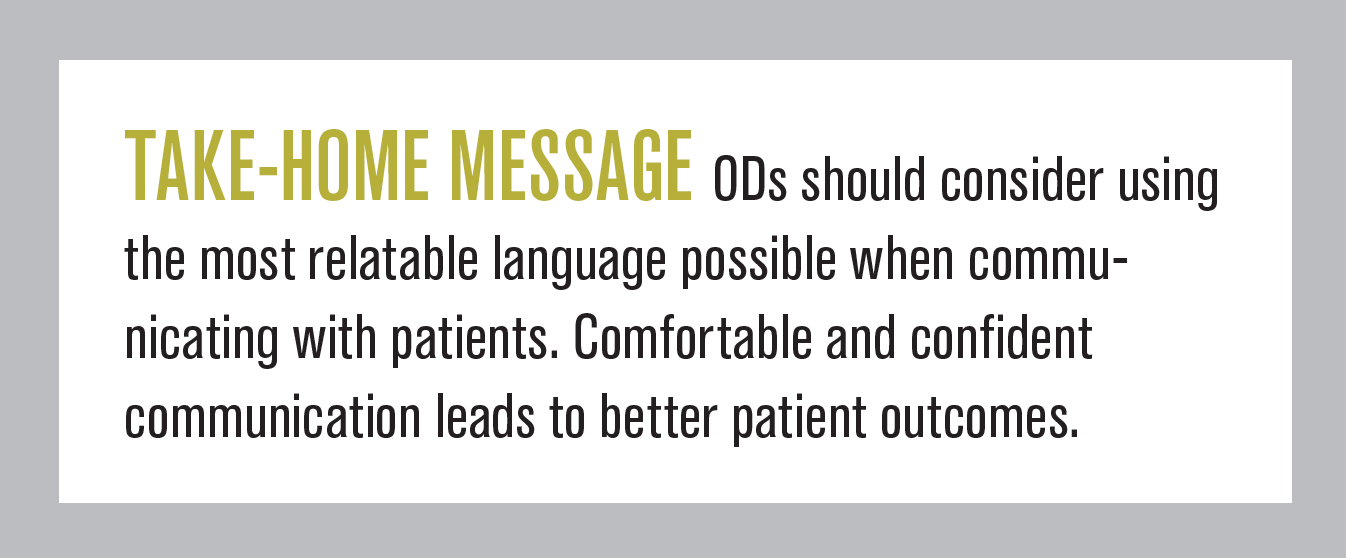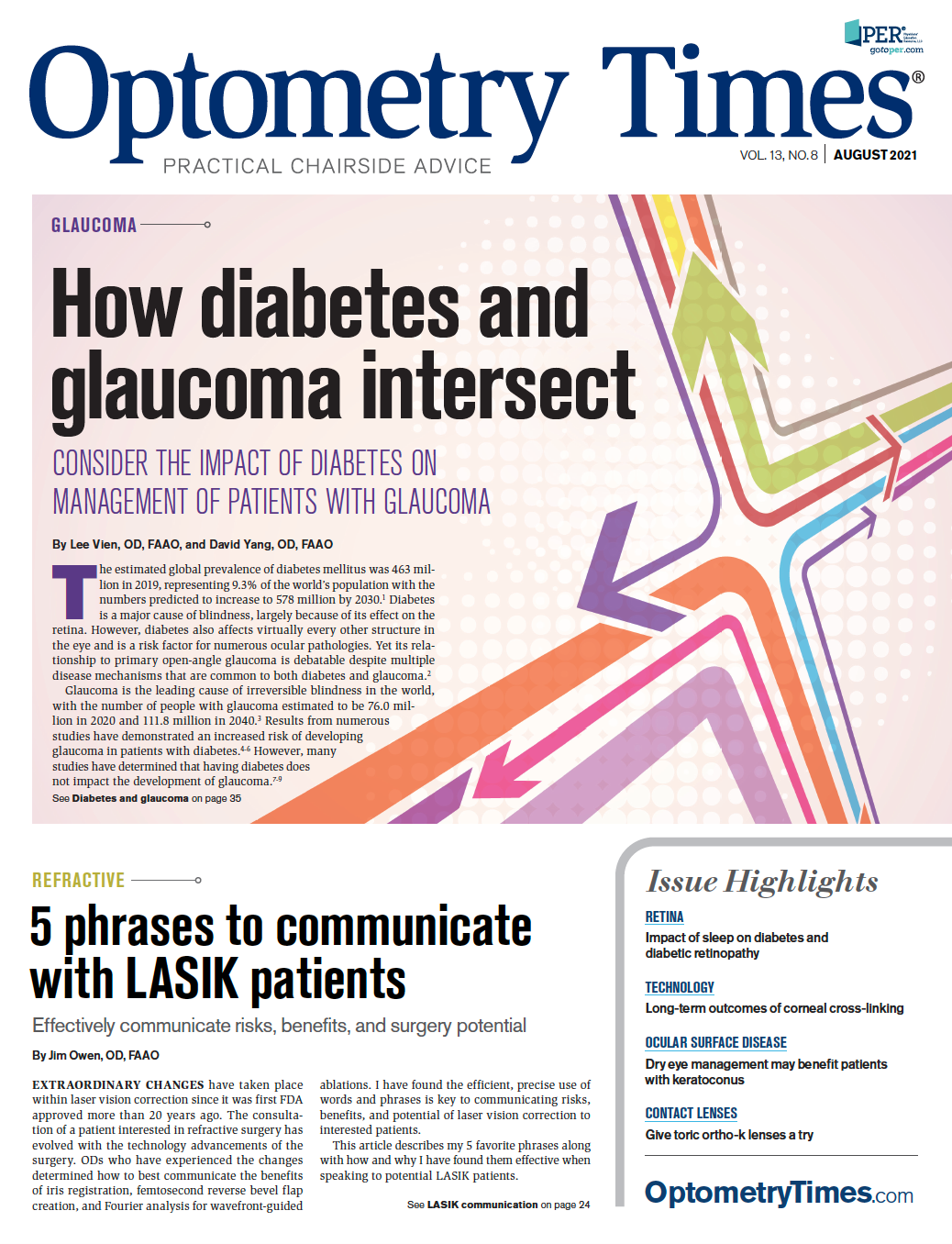5 phrases to communicate with LASIK patients
Effectively communicate risks, benefits, and surgery potential


EXTRAORDINARY CHANGES have taken place within laser vision correction since it was first FDA approved more than 20 years ago. The consultation of a patient interested in refractive surgery has evolved with the technology advancements of the surgery. ODs who have experienced the changes determined how to best communicate the benefits of iris registration, femtosecond reverse bevel flap creation, and Fourier analysis for wavefront-guided ablations. I have found the efficient, precise use of words and phrases is key to communicating risks, benefits, and potential of laser vision correction to interested patients.
This article describes my 5 favorite phrases along with how and why I have found them effective when speaking to potential LASIK patients.
1. What has you interested in laser vision correction today?
I start every refractive surgery consultation with the same question. After the pleasantries of, “Where are you from?” to “Don’t you love the Padres?” I ask, “What has you interested in laser vision correction today?”
This is a “what” question, not a “why” question. “Why” questions may make people defensive or create negative emotions. “What” questions show more curiosity. Former FBI hostage negotiator Chris Voss discusses in his book Never Split the Difference how “what” questions are taken as less pushy and are more likely to encourage a person to stop and think. For example, the question of, “Why are you going up the stairs” could elicit the terse response, “Why do you care?” vs “What are you going to get upstairs?” The robustness of the patient’s answer provides the clinician with valuable information about their interest in laser vision correction.
The “today” part of the question addresses, why now? Virtually all LASIK patients have conducted internet research, have a friend who has had LASIK, and have been myopic since they were 15 years old. So, why now?
The answers are balanced between being “fed up” with their current correction of glasses or contact lenses or finances now allow the surgery. Recently, many patients have mentioned how they have extra money from not traveling or eating out, or they are tired of their glasses fogging up from facemask wear. No matter the specific reason, this question gives me insight into the patient and their motivation and concerns. The most common initial response to my question is, “I have been thinking about LASIK for a long time.” That really doesn’t answer my question, but I never say that out loud.
2. We can’t predict how you will heal. Some patients overrespond to the treatment, and some underrespond
I try to cover expected outcomes and complications of the surgery in a conversational manner. A second surgery or enhancement has become less common over the years, but it is certainly possible and can be more likely depending on refractive error. When speaking about enhancement procedures I say: “We can’t predict how you will heal. Some patients overrespond to the treatment, and some underrespond.” I give a percentage based on our surgeon’s actual outcomes for their refractive error range.
Unfortunately, patients can believe they need an enhancement procedure because the doctors did something wrong or the surgery didn’t work. Neither is true, but those reasons seem rational to a patient. I have found that patients understand variability in healing. Occasionally, they will report unusual healing in other procedures, which may or may not be valuable information.
I inform patients that if an enhancement is needed, their vision is likely to easily improve and the procedure will take place 3 to 6 months after the first surgery. I also mention that the second surgery does not incur an additional charge. With those last statements, the patient’s body language most often changes to a receptive position.
We signal to patients that LASIK is “real” surgery and should be taken seriously. These signals include a surgeon in scrubs (yes, some just wear street clothes), the deliberate time-out procedure, and a rigid scheduling process. I think it is a mistake to create the impression that LASIK can be performed along with your nails. However, we avoid extremes, and the laser center feels nothing like a hospital. The goal is to present a comfortable and professional environment. Similarly, the postoperative experience for LASIK is different than most surgeries because patients have good vision the next day.
3. Most patients see very well the next day
When I discuss postoperative care, I say, “The magic of this remarkable procedure is that most people see very well the next day.” It really is magic when thinking about a cool laser vaporizing human corneal tissue in such a precise manner that curvature is altered exactly to allow light to be focused on the retina. This event is both wonderful and exciting while remaining mysterious to most people.
Most surgeries entail a longer recovery period before the patient is aware of the benefit. For example, professional baseball pitchers welcome the possibility of being back to full strength in a year vs 18 months after Tommy John or ulnar collateral ligament reconstruction surgery. The question on most patients’ minds is, “When can I go back to work?” Although it depends what they do for work, most patients can have surgery on Friday and be back to work on Monday. It truly is magical.
4. Think of your cornea as a 540- page book
My colleague Jimmy Jackson, OD, taught me the book analogy many years ago, but it still holds up. Today, patients can watch any type of surgery on the internet, and I have found that those who are curious watch. Nevertheless, I think it is important for my patients to have a basic understanding of the process of surgery. That is where the book story comes in.
Start with: “Think of your cornea as a 540- page book” (or the patient’s specific corneal thickness). Then continue the narrative. We are going to open the book to page 120, laser away X pages (the appropriate amount of pages as if pages were microns), and close the book. The FDA says we need to leave 250 pages in the book, and in your case, there are 320 pages left.
This analogy can be the framework to describe why a cornea is too thin, why we can’t remove a high amount of myopia and even PRK in which we remove the cover and laser starting with page 1. It has worked astonishingly well with my patients. A low percentage of patients have more detailed questions, but the book analogy provides enough detail for the average patient.
5. 20/Happy
20/Happy was a phrase coined by John Potter, OD, in the late 1990s and a phrase I continue to use every day. The goal of laser vision correction is 20/Happy. Think about the patient for whom you increased the cylinder by 1.00 D in their spectacles and a week later, they complain that the glasses make them sick despite being clear. They are not 20/Happy.
Most patients nod when I say 20/Happy, but occasionally a patient will retort, “No, I want it perfect.” My 20/Happy phrase may have flushed out someone with unrealistic expectations, certainly a patient for whom the outcomes discussion requires more clarity. This simple, clever phase is an effective probe into the makeup of the patient without them knowing the motivation.
Conclusion
Patients in 2021 almost always have a close relative or friend who has had laser vision correction. That relationship gave them the courage to ask about laser vision correction for themselves. Additionally, countless resources, both good and bad, exist on the internet, so the ODs’ job is to provide a factual, representative depiction of the procedure.
The words ODs use are important. I continue to refine what I say, usually making explanations more precise with the most common language possible. While my phrases are certainly not for everyone, find your own voice with your own words. Confident and comfortable communication helps to best care for patients.


Newsletter
Want more insights like this? Subscribe to Optometry Times and get clinical pearls and practice tips delivered straight to your inbox.